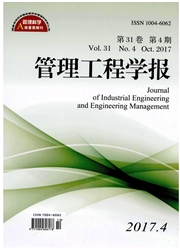

 中文摘要:
中文摘要:
本文以空间计量经济学为理论基础,并借鉴Cobb–Douglas生产函数,构建了省域工业绿色技术创新产出的影响因素理论模型,其中绿色技术创新产出为被解释变量,绿色R&D投入、绿色创新人员投入为解释变量,环境规制强度、人均GDP及滞后一期的绿色技术创新产出为控制变量;假设省域工业绿色技术创新产出具有空间自相关性,并基于2004-2012年三个阶段的跨期数据,运用全域Moran’s I指数、局域Moran散点图和LISA集聚地图对绿色技术创新产出进行全域和局域空间自相关性检验,揭示了省域工业绿色技术创新产出的时空演化特征;应用OLS、SLM、SEM对省域工业绿色技术创新产出的影响因素进行估计。研究结果显示:我国省域工业绿色技术创新产出具有明显的空间依赖性,在地理空间上存在集聚现象;绿色R&D投入和人均GDP对省域工业绿色技术创新产出具有显著的影响效应,环境规制强度对绿色技术创新产出的影响存在“阈值效应”,而绿色创新人员投入和滞后一期绿色技术创新产出的影响效应不显著。
 英文摘要:
英文摘要:
According to the spatial economics theory, economic activities and economic growth always reveal significant spatial clustering characteristics. As a result, innovation interaction coming from spatial clustering can effectively improve green technological innovation output in provinces. Furthermore, due to the path-dependent and self-locking characteristics, industrial green technological innovation output shows a distinct spatial-temporal difference in different provinces. Therefore, it is necessary to explore spatial clustering and differentiation in order to promote the coordinated development of provincial industrial green technology innovation. In order to achieve this goal, using industrial level data of 30 provinces in China from 2004 to 2012, we apply the spatial econometrics method to analyze spatial-temporal evolution characteristics and impact factors of green technological innovation output. The main content includes the following: Firstly, giving the spatial correlation analysis principle and using idea obtained fTom Cobb-Douglas production function, we build up a spatial econometrics model to analyze the relationship between green technological innovation output of Chinese provincial industries and its factors. In this model, green technological innovation output is regarded as explained variable. Green R&D input and green innovation personnel input are considered as explanatory variables. Environmental regulation intensity, per capita GDP and log green technological innovation ou~out are treated as controlled variables. In addition, we also describe these variables meaning and their measurement methods. Secondly, we concentrate on explaining spatial-temporal evolution characteristics of industrial green technological innovation output in different provinces Using three phases of the inter-period data, we apply global Moran's I indexes, local Moran scatter diagrams, and LISA clustering maps to explore global and local spatial autocorrelation on green technological innovation output. The resu
 同期刊论文项目
同期刊论文项目
 同项目期刊论文
同项目期刊论文
 期刊信息
期刊信息
